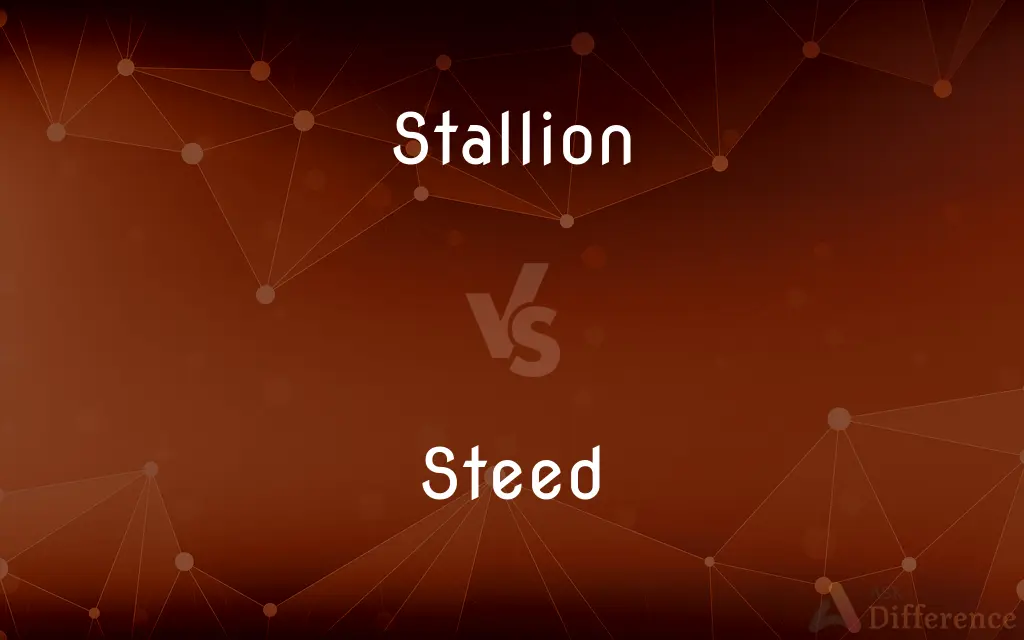Stallion vs. Steed — What's the Difference?
By Tayyaba Rehman & Maham Liaqat — Updated on March 8, 2024
A stallion is an adult male horse known for its strength and breeding capabilities, while a steed is a term used to describe any horse, often emphasizing its role in riding or as a noble companion.

Difference Between Stallion and Steed
Table of Contents
ADVERTISEMENT
Key Differences
Stallions are distinguished by their gender and reproductive status; they are adult male horses that have not been castrated, allowing them to breed. They are often noted for their vigor, strength, and sometimes challenging behavior due to high levels of testosterone. On the other hand, the term steed is more general and can refer to any horse, regardless of gender or breeding status, but is traditionally used to denote a horse that is being ridden or has qualities admired in a riding horse, such as speed, strength, and loyalty.
While stallions are specifically valued in breeding for their traits and pedigree, contributing to the genetic pool of horse breeds, steeds are celebrated in literature and history for their relationship with their riders, often depicted as faithful and brave companions in battles and adventures. The role of a stallion is therefore biological and functional within the context of equine management and breeding, whereas a steed's role is more symbolic, often tied to the horse's performance, demeanor, and bond with its rider.
The management of stallions requires special considerations due to their aggressive tendencies and high energy levels, necessitating experienced handling to ensure safety and effective training. Steeds, by contrast, are selected for their temperament and physical capabilities, especially for tasks such as riding, work, or show, without specific regard to their reproductive abilities.
Steeds were often chosen from the best available horses, regardless of their breeding status, to serve as reliable mounts in various endeavors, from daily travel to warfare. Stallions, with their specific breeding role, contribute to the development and maintenance of horse breeds, emphasizing traits like strength, endurance, and temperament that might make them or their offspring suitable as steeds.
The appreciation of stallions in horse breeding and equine sports is rooted in their physical and genetic qualities, while the admiration for steeds is often related to their role in human history, literature, and personal bonds formed with riders. Both terms reflect the multifaceted relationship between humans and horses, highlighting different aspects of equine strength, capability, and companionship.
ADVERTISEMENT
Comparison Chart
Definition
An adult male horse, not castrated
Any horse, often used for riding
Primary Role
Breeding
Riding or companionship
Selection Traits
Strength, pedigree, reproductive ability
Speed, strength, temperament for riding
Management Needs
Experienced handling due to behavior
Depends on specific use, less focused on breeding
Symbolic Role
Contribution to breed quality
Noble companion in literature and history
Compare with Definitions
Stallion
Known for vigor and strength.
The stallion displayed remarkable stamina in the race.
Steed
Symbol of nobility and bravery.
Legends often recount heroes and their loyal steeds.
Stallion
Requires careful management.
Handling the spirited stallion demanded expertise and patience.
Steed
Reflects the bond between horse and human.
The bond with his steed was evident in their seamless communication.
Stallion
Often used in competitive sports.
The champion stallion excelled in show jumping events.
Steed
Chosen for physical and temperamental qualities.
The steed's swift pace and gentle nature made it ideal for long rides.
Stallion
Contributes to genetic diversity.
Breeders valued the stallion for his exceptional traits.
Steed
A horse used for riding.
The knight mounted his trusty steed for the journey.
Stallion
Adult male horse, capable of breeding.
The thoroughbred stallion was prized for his impressive lineage.
Steed
Integral to historical and literary narratives.
The warrior's steed became as famous as its rider.
Stallion
A stallion is a male horse that has not been gelded (castrated). Stallions follow the conformation and phenotype of their breed, but within that standard, the presence of hormones such as testosterone may give stallions a thicker, "cresty" neck, as well as a somewhat more muscular physique as compared to female horses, known as mares, and castrated males, called geldings.
Steed
A horse being ridden or available for riding.
Stallion
An uncastrated adult male horse.
Steed
A horse, especially a spirited one.
Stallion
An adult male horse that has not been castrated, especially one kept for breeding, or an adult male of another equine species.
Steed
An animal used for riding
The use of camels as steeds.
Stallion
(Slang) A man regarded as virile and sexually active.
Steed
(Informal) A vehicle, especially one that is ridden astride such as a bicycle or motorcycle.
Stallion
An adult male horse.
Steed
A stallion, especially in the sense of mount.
Stallion
Specifically, one that is uncastrated.
Steed
A bicycle.
Stallion
A male horse kept primarily as a stud.
Steed
A horse, especially a spirited horse for state or war; - used chiefly in poetry or stately prose.
Mounted upon a hot and fiery steed.
Stallion
A very virile and sexually-inclined man or (rarely) woman.
Steed
(literary) a spirited horse for state or war
Stallion
A male horse not castrated; a male horse kept for breeding.
Stallion
Uncastrated adult male horse
Common Curiosities
What qualities make a good steed?
Good steeds are chosen for their speed, strength, reliability, and suitable temperament for riding or companionship.
Is the term 'steed' still commonly used today?
While less common in everyday language, 'steed' is still used in literary and historical contexts to evoke nobility and valor.
What differentiates a stallion from other horses?
A stallion is an adult male horse that has not been castrated, distinguished by its reproductive capability and often its strength and temperament.
What historical significance does a steed have?
Steeds have a rich historical significance, often associated with knights, warriors, and heroes as loyal and brave mounts.
Can mares and geldings be considered steeds?
Yes, mares and geldings can also be considered steeds if they are used for riding or fulfill a role similar to that traditionally associated with steeds.
Can a stallion be a steed?
Yes, a stallion can be a steed if it is used for riding or as a mount in various activities, combining both terms' characteristics.
Why are stallions often chosen for breeding?
Stallions are chosen for breeding due to their desirable physical traits, strength, and pedigree, which can enhance breed qualities.
What role does a stallion play in equine sports?
Stallions often play significant roles in equine sports, showcasing their speed, agility, and competitive spirit, and contributing to the sport's genetic excellence.
What is the main consideration when selecting a horse to become a steed?
The main considerations include the horse's physical abilities, temperament, and suitability for the rider's needs and activities.
How does one train a stallion for breeding?
Training involves socialization, habituation to handling, and specific training to behave appropriately during breeding encounters.
How do caretakers manage a stallion's behavior?
Experienced handlers use specialized training and management techniques to safely manage stallions' aggressive tendencies and high energy.
Are steeds always warhorses?
Not always; while the term 'steed' can refer to warhorses, it broadly encompasses any horse used for riding, not limited to martial contexts.
What literary works feature notable steeds?
Many, including "Don Quixote" and "The Lord of the Rings," feature steeds as central to their stories, showcasing the deep bond between horse and rider.
How do cultural perceptions of stallions and steeds differ?
Cultural perceptions vary, with stallions often seen as symbols of power and virility, while steeds are viewed as noble companions, reflecting the values and traditions of each culture.
Why is pedigree important in selecting a stallion for breeding?
Pedigree is crucial as it ensures the transmission of desirable traits to offspring, contributing to the quality and performance of future generations.
Share Your Discovery

Previous Comparison
Con vs. Racket
Next Comparison
Romanichal vs. GypsyAuthor Spotlight
Written by
Tayyaba RehmanTayyaba Rehman is a distinguished writer, currently serving as a primary contributor to askdifference.com. As a researcher in semantics and etymology, Tayyaba's passion for the complexity of languages and their distinctions has found a perfect home on the platform. Tayyaba delves into the intricacies of language, distinguishing between commonly confused words and phrases, thereby providing clarity for readers worldwide.
Co-written by
Maham Liaqat















































